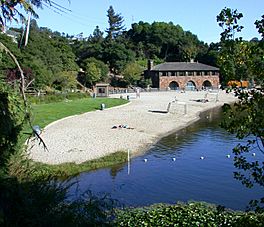Lake Temescal facts for kids
Quick facts for kids Lake Temescal |
|
|---|---|
 |
|
| Location | Oakland, California |
| Coordinates | 37°50′52″N 122°13′53″W / 37.84778°N 122.23139°W |
| Type | Reservoir |
| Primary inflows | Temescal Creek |
| Primary outflows | Temescal Creek |
| Basin countries | United States |
| Max. depth | 20 ft (6.1 m) |
| Surface elevation | 433 ft (132 m) |
Lake Temescal is a small reservoir located in the hills of northeastern Oakland, California. It is the main part of the Temescal Regional Recreational Area, also known as Temescal Regional Park. This park is managed by the East Bay Regional Park District.
Contents
The Story of Lake Temescal
How the Lake Was Formed
Lake Temescal gets its name from Temescal Creek, which feeds into it. In 1868, a dam was built across this creek. This created the reservoir, which was used to supply drinking water to the wider East Bay area. The Contra Costa Water Company, owned by Anthony Chabot, managed this water supply.
Before the dam was built, Lake Temescal was a natural dip in the land called a sag pond. This dip was formed by the Hayward Fault. Many Chinese immigrants helped build the dam. They did most of the hard work, digging and moving soil to reach the bedrock. Wild mustangs (horses) were used to pack down the huge amounts of dirt needed for the dam. The dam is about 600 feet (180 m) long and 16 feet (4.9 m) wide. It stands 105 feet (32 m) above the creek.
Artists and Early Developments
In the late 1800s, the lake's shores were a popular camping spot for artists and writers. For example, the British painter J.H.E. Partington lived there in a tent with his family when they arrived in Oakland in 1889.
Later, in 1921, Pacific Gas and Electric started building its Claremont substation right above Lake Temescal. It opened in October 1922 and is still in use today.
Changes Over Time
During the first half of the 1900s, the tracks of the Sacramento Northern Railroad ran along the eastern side of the lake.
Until the mid-1930s, Lake Temescal stretched further northeast into Temescal Canyon. A bridge for the Sacramento Northern railway crossed this part of the lake. However, this inlet was filled in as part of the Broadway Tunnel (Caldecott Tunnel) project. A large concrete wall was built along the east side of the lake to support the new fill. The railroad bridge was removed, and the tracks were moved slightly lower. Later, the Warren Freeway and Grove-Shafter Freeway replaced these roads. The retaining wall is still there, but the railroad tracks were removed by 1957.
Opening to the Public
In 1936, Lake Temescal became one of the first three parks opened by the East Bay Regional Park District. It offered a beach for swimming, a boathouse built by the WPA, a walking trail around the lake, and many picnic areas.
Lake Temescal Today
Fun Activities at the Lake
Today, Lake Temescal has a beach area for swimming and is regularly stocked with fish. You can find rainbow trout, largemouth bass, redear sunfish, bluegill, and catfish here. The park is open every day from 5 am to 10 pm. About 200,000 people visit the park each year.
The California Office of Environmental Health Hazard Assessment (OEHHA) gives advice on eating fish from Lake Temescal. This is based on levels of mercury or PCBs found in the fish.
Lake Depth and Safety
The lake is always getting shallower because of dirt and sand washing into it. This means it needs to be cleaned out regularly. Today, the deepest part of the lake is about 20 feet (6.1 m). It used to be much deeper, around 80 feet (24 m).
Because the dam is built across the Hayward Fault, there was once a concern about the dam breaking during an earthquake. This could cause serious flooding in parts of Oakland, Berkeley, and Emeryville. However, extra material has been added between the dam and Highway 24, making a dam failure very unlikely now.
During the 1991 Oakland firestorm, helicopters used water from Lake Temescal to fight the fires. This almost completely drained the lake.
Park Facilities
The beach house at Lake Temescal can be rented for events, like weddings.
Since 2014, the park's beach and swimming area have sometimes been closed. This is due to outbreaks of blue-green algae, which can be harmful.



